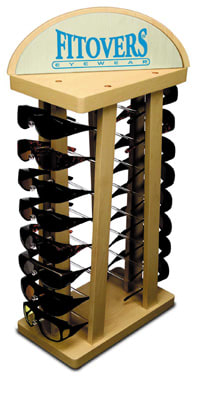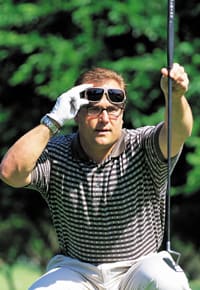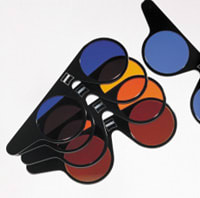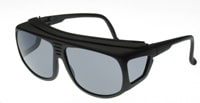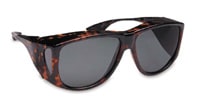A
Perfect Fit
Fit-over style sunwear for Rx eyeglass
wearers is coming into its own as a profitable and necessary niche business. Here, dispensers share their strategies for successful dispensing of over-prescription
sunwear.
By Erinn Morgan
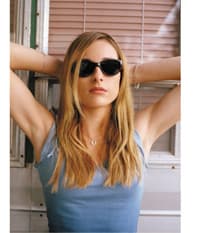
According to industry experts, the first over-prescription sunglasses were invented in the U.S. in 1979. Manufactured by Dioptics, the product was branded SolarShield™, and more than 20 million frames have been sold to date. Over the years, the over-Rx product lines from various manufacturers have developed into an extended array of models, including those with polarized lenses, UV protection, and adjustable temples for standard Rx coverage as well as low vision and post-surgery applications. What had long been a functional item is now designed to be fashionable as well.
The growth of over-prescription sunwear is undeniable-- some optical dispensers lay claim to increases in the last year of 20 to 100 percent. "We have had a 20 to 25 percent growth in the category," says Lynn Herber, a supervisor at Mayo Optical, a division of the Mayo Clinic based in Rochester, Minn.
Many ECPs say their sales have increased exponentially. "Sales grew more as I became more comfortable and confident with the product myself--to the point where I started putting them on everybody," says Catherine Hernandez, owner of Optically Yours in Belleview, Fla.
Some dispensers say that a number of customers are even buying two pairs at a time. "This business has doubled for us in the last few years," says Jane Kluesner, frame buyer at Styleyes in Madison, Wis. "Some people even buy two pairs for their cars because the price is not prohibitive."
|
|
|
|
Over-Rx sunwear, such as Live Eyewear's Extreme style (left), appeals to a growing demographic. The Fitovers display (right) is a great way to build the category |
BRIMMING WITH BENEFITS
The growth of over-Rx style sunwear is not surprising, as its features are plentiful. "We promote this product because it is lightweight, affordable, has side coverage, and is polarized," says Mary Ann Wolter, optician at Neist Eye Clinic in Fairmont, Minn.
One selling point is that many fit-over sunwear styles feature glare-reducing polarized lenses. "Some of the older styles have just a molded piece of poly. These new ones have a ground lens with good optical quality," adds Wolter.
Even with these qualities, prices remain low--on average from $40 to $80. "We would charge almost twice as much to add the polarized lens option to their prescription lens," she says.
In today's economy, patients may bristle at the suggestion of a second pair of prescription sunwear. "If you were to get polarized single-vision prescription sunglasses here you would be spending an average of $294," says Beth Wullner, optician at Discover Vision, which has six locations in the Kansas City area. "Today, most people don't want to spend the money on a complete pair of Rx sunwear and the fit-over eyewear is a great option."
PERFECT ORDER
Presentation is key when it comes to over-prescription sunwear. A presentation that discusses all options, beginning with a second pair of prescription sunwear is a good starting point. If this does not appeal to the client, educate them about clip-on sunwear or photochromic lenses. The next step is to discuss over-Rx sunwear.
"We always ask them if they have sunglasses," says Kluesner. "If they are turned off by the price of prescription glasses, then we show them fit-over styles."
Some dispensers recommend showing over-prescription sunwear to everyone. "I show it to every customer," says Optically Yours, Inc.'s Hernandez. "I reach over my shoulder, grab a pair off the shelf behind my dispensing table, and put them on."
|
|
| Over-prescription style sunwear features glare-reducing polarized lenses with good optical quality. Above: Fitovers' Aurora style. |
Knowledge is power for customers. "We educate them on what fit-over eyewear is and why they would benefit from it," says Wolter.
While this product has typically been purchased by the older set, younger customers are also discovering it. "People in the range of 35 on up buy them," says Barb Biergutz, optician at Feidler Optical in Norfolk, Neb. "Younger people like them because they are polarized and have side coverage that keeps wind out."
|
|
|
|
Live Eyewear's Cocoon style. |
|
Proper merchandising of this product is crucial in piquing the interest of the customer. Displays can be placed directly on dispensing tables to grab their attention while they order eyewear.
"We keep the fit-overs on a display on the dispensing desks," says Herber. "Because of where it's sitting, more people ask about it." Others disperse them around the dispensary. "We have about 25 pairs sitting out at all times in every size," says Wolter.
Sales of over-prescription sunwear can be expected to increase going forward. The baby boom generation is getting older--a plus to this category. And as styling gets younger, sales will increase to those in their 30s, 40s, and 50s.
|
|
|
|
Fitovers' sporty gear is an alternative to Rx sunwear |
Live's floor display |
While the category may cut into second-pair or clip-on sunwear sales, the majority of ECPs see fit-overs as an additional sale, not a replacement for second-pair sales. The bottom-line benefit is two-fold: Over-prescription style sunwear will increase sales, and the option will benefit patients by providing them with a convenient, functional, and low-cost product.
|
Great Strategies |
Some dispensers of fit-over style sunwear employ unique and effective tactics for selling the product. Here, we share a few of the best. Loaner pairs. At Neist Eye Clinic in Fairmont, Minn., opticians provide loaner pairs of over-prescription sunwear for customers to wear over their old glasses while waiting for their new prescription eyewear. "We have five pairs that we loan out while they are waiting for their Rx to get back from the lab," says optician Mary Ann Wolter. "We have never had anyone come back and say they don't want to buy a new pair. That's been a great selling tool for us." Glare box. Also at Neist Eye Clinic, dispensers use a special glare demonstration box to show the benefits of polarized lenses. "We have a glare box that we purchased through our lab," says Wolter. "The patient looks into the box and sees a road, sun, trees, and glare. We show them a sunclip that darkens it. Then we show them a polarized lens, and they are amazed at the depth perception plus glare reduction. A lot don't know what polarized lenses are about, so we educate them." Getting outside. Some dispensers make sure they take all their customers outside when demonstrating polarized fit-over style sunwear. "We show them the difference between polarized and tinted lenses. We have them stand outside and show them how they still have to squint in the sun with tinted lenses. Customers love this demonstration," says Barb Biergutz, optician at Feidler Optical in Norfolk, Neb. Presenting polarized. Finally, some dispensers use fit-over style sunwear to demonstrate polarized lenses. Customers can keep their prescription eyewear on while testing polarization. Beth Wullner, optician at Discover Vision, which has six locations in Kansas City, notes, "We use either brown or gray lenses or show them both. About 50 percent of the time we sell them the fit-over, and the other times we sell polarized prescription sunwear." |
|
A Different Vision |
|||
Fit-over style sunwear and absorptive filters have been used for years for low vision applications. Today, new and improved products on the market from companies such as Eschenbach, NoIR Medical Technologies, and Vision Advantage are helping to grow this end of the business even further. Here's a closer look at over-Rx styles that are used in low vision, and what eyecare professionals have to say about how this eyewear can benefit their patients. NoIR. The firm offers sun filters for the partially sighted, post-operative cataract patients, and recreationalists. With more than 50 lenses of differing colors and transmission characteristics, NoIR Medical Technologies' UVShield filter system manages the light that reaches the eyes to maximize functional vision, enhance contrast, and provide comfort against disabling glare. By reducing overall light transmission and eliminating bothersome frequencies of light, UVShield filters can increase mobility and provide wearers with relief from the light-sensitivity, glare, and discomfort related to the onset of macular degeneration and other vision-impairing eye conditions, including night blindness. Eschenbach. The SolarShield™ line of absorptive filters, manufactured by Dioptics and distributed by Eschenbach, includes two different frame styles--a larger shape called the SolarShield™ Aviator and a medium shape called the SolarShield™ Cateye. These frames come in four different tints, including yellow (450 nanometers), orange (525 nanometers), amber (511 nanometers), and gray (400 nanometers). Vision Advantage. A relative newcomer to this category, Vision Advantage has formed a strategic alliance with Fitovers Inc. Vision Advantage will both distribute existing Fitovers product to the low vision segment and market a specially designed Fitovers Inc. style for Zeiss medical filters. HOW DOCTORS DISPENSE THEM The first step to dispensing these helpful products is to ask patients about their vision problems to make an accurate determination of how over-Rx style sunwear can be of service. "Every patient here is queried if they have any light sensitivity or glare," says Lou Frank, OD, chief optometrist of Low Vision Services at the New England Eye Institute in Boston (who also has a private practice in Danvers, Mass.). "The optimal technique for evaluating that is to take the patient outside, introduce them to several different types of absorptive filter tints, and select which filters the most for them--whether that be a high transmission filter, low, or something in the middle," he says. The important thing to remember is that while the majority of those who need this type of filter will be seniors, there is really no age limit on usage. "My personal patient population tends to be the elderly," says Frank. "In the college's population I see some children who need these types of filters their entire life. There is no age limit to consider." With the better products of today, dispensers can suggest this option without hesitancy to all of the patients who can benefit. "I recommend them to everyone--most low vision patients can get a benefit from it," says Lance Alpert, OD at TotalVision Eyecare Center in Manchester, Conn. "The benefit is that the quality is good. The optics of the lens is better. And a lot are polarized. In addition, many of the frames have rubber temple tips so the patients can actually adjust them themselves," he adds. This type of product is typically introduced during the exam for low vision or other problems, but many eyecare professionals also keep them on display in the dispensary so patients see them while looking around. The consensus is that this important segment of eyewear will see future growth. "I think it's growing for two reasons," says Frank. "The demographics of aging suggest that the number of people with partial vision will grow dramatically; additionally, eyecare professionals are not considering the issue of glare with patients as much as they should, so there is room for growth here. It has to be an integral part of the low vision exam." Another reason for increases in this niche is that products are getting better looking and even more functional. "I absolutely think we'll see this area grow," says Alpert. Talking about styling, Alpert adds, "We have seen a couple of generations of them--in the beginning they were clunky and not streamlined. There will be an evolution of the design and thus more acceptance of this eyewear option. And, they won't have the negative connotations that go with the old versions."
|
|||




